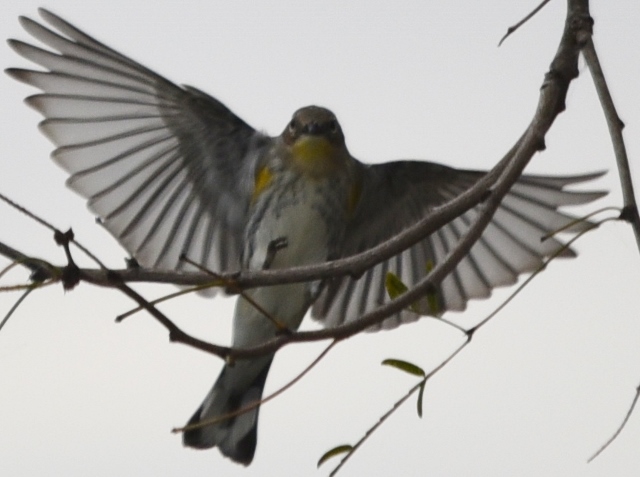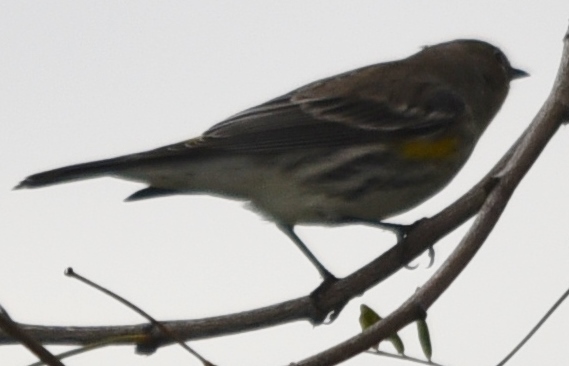
I’m a window snooper — looking out — not peeping in on other people! I’m interested in what’s happening outdoors while I’m in the house. The opposite is not true.
I get amazing, spur-of-the-moment bird shots all the time because I keep my camera handy with the long lens attached, battery charged, camera in on position and set at auto.
What’s amazing actually is when I happen to capture something usable — like the above photo. The focus is relatively good and the bird is doing something noteworthy — in this instance, portraying an angel come to bestow a New Year blessing on our yard.
A bit fanciful perhaps, but it is the new year and blessings need to be bestowed.
Why I suspect the image in the photo to be an angel is because I can’t find a photo of a bird with those particular markings in my birding book.
The bird appears to have yellow and blue splotches across its chest and underarm area. Yes, most professional birders would use different terms to describe the anatomy of a bird, so I need not mention that I’m a novice birdwatcher
Birdwatching is like learning a foreign language, in that if you didn’t start at age six, you’re going to have a difficult time unless you have an eidetic memory. If not eidetic, at least you’re still reasonably capable of some sort of memorization skills.
As in any other science, every part of a bird’s anatomy has a specific name.
To overcome lapsing memory or non-eideticism, exceptional birding reference books are a must. An ideal book would be one that shows color pictures of both male and female birds, seasonal variations, juvenile plumage variations, and indeed even first, second, or third winter or summer plumage differentials. Most professional birders have a library of birding reference books.
Too many veritable plumage variations makes my head spin and renders me incapable of learning, which is why I’m glad to be on e-mailing terms with noted Valley birding experts.
My first exciting thought about our mystery angel-bird with the blue and yellow splotches, was that it was parula. I could only remember the first letter of the bird name so had to succumb to page-by-page research in my 573-plus page birding book. The pages soon revealed that the undercarriage of the bird I photographed resembled a Canada Warbler.
I was SO excited because I’d never seen a Canada Warbler. I was in the middle of sending an e-mail to my local expert who occasionally IDs birds for me. I attached a couple of photos and was exclaiming how exciting it all was when, alas, I noticed the little “range” map on the Canada Warbler page.
If my find were indeed a Canada Warbler, the bird would have been so totally out of its range that only a complete fluke or strong hurricane-force wind could have possibly gotten this particular bird to the Rio Grande Valley!
My second, and more rational, thought was that it was a juvenile of some sort. I quickly added that note to my e-mail and sent the views off to the expert.
Herein lies the lesson in this missive: Juvenile plumage is nothing to be sneezed at. But, learning about key points will almost certainly help lead you to correctly identifying birds. In my case, one very good tell is, where the white is — both the white on the wings and the white eye ring are clues.

Although not note-worthy photos, taken with a hand-held long lens, hasty snaps at a moving target on an overcast day and shooting through glass doors, luckily they are good enough for identification purposes.

My expert’s opinion is that I most likely photographed a juvenile yellow-rumpled warbler. I can see it all clearly now, of course, because we have yellow-rumped warblers each winter.
There are many birding books. Most will have introduction pages that point out the topography of a bird and give tips for the field.
There are clues to look for when beginning to identify a bird. I have a good pair of binoculars and a scope, but I find it’s more fun to photograph and study a bird at my leisure with the photo on my computer screen while I compare it with images in a book.
A few field clues to consider:
Bird’s head
Bill or beak size, shape
Face markings
Overall shape and size of bird
Body markings
Shape of tail
That’s just to begin with. The best way to learn to identify birds is to join a group of professionals and go on field trips with them.
Birders will hit the road in a heartbeat if there’s a possibility of seeing birds. And being winter in the Rio Grande Valley, there is no shortage of birding opportunities.
The first important date in the birding world is Saturday, January 5. If you don’t feel experienced enough to join the pro-birders, backyard feeder counts are just as important.
The president of the local birding organization, Arroyo-Colorado Audubon Society (ACAS), Norma Friedrich, encourages participation in Saturday’s National Audubon Society Christmas Bird Count for those interested in being Feeder Watchers.
Here is an excerpt from her instructions notice:
Thank you in advance. We realize that everyone is busy and some cannot spend a whole day counting. Totals gathered at feeders or in the yard when possible on count day can greatly enhance the quality of our count.
Even a few minutes spent watching the feeder can be important.
Please make sure that your feeder is within the count circle by checking with Mark Conway at 956-245-8992 or Norma Friedrich at 361-676-6416.
Bird identification should be taken seriously but should not prevent you from taking part.
If you can identify 5 birds out of 20, those are 5 correctly identified birds that we would not otherwise have.
Rare birds should be documented using the appropriate form. Contact the e-mail address below for the form and instructions.
How to count:
Birds coming to feeders should not be totaled over the entire day. Only the high number of individuals of any species seen at one time should be added to your yard count.
Example: When watching a feeder over the course of a day, if 6 black-crested titmice are seen all at once, then leave, 2 more appear, then leave and later 2 individual titmice visit the feeder; the number of black-crested titmice that you count for the day is 6, not 10.
Request a birding list here: acaskiskadee@yahoo.com
Please send a copy of your total bird count for Saturday, January 5, by email to acaskiskadee@yahoo.com before January 10.
